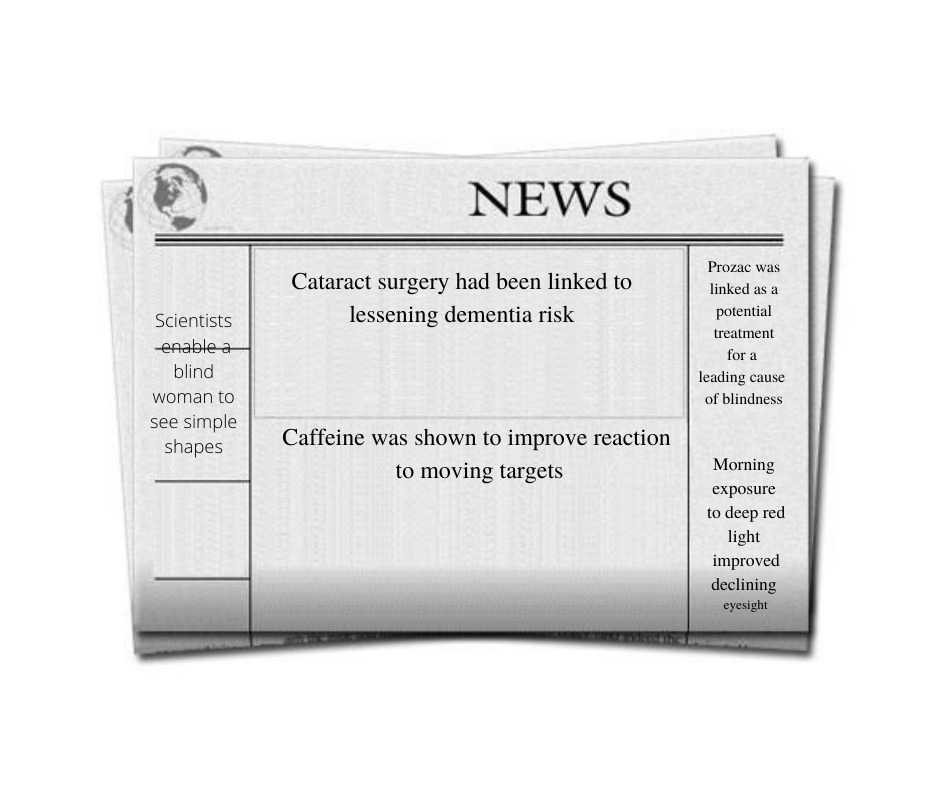 2021 brought much uncertainty as the COVID-19 pandemic continued in 2021. 2021 also brought us discoveries and breakthroughs in vision care.
2021 brought much uncertainty as the COVID-19 pandemic continued in 2021. 2021 also brought us discoveries and breakthroughs in vision care.
- Cataract surgery had been linked to lessening dementia risk. Researchers from the University of Washington school of medicine in Seattle conducted an observational study of more than 3000 adults aged 65 or older. The research has suggested a link between cataract surgery and a reduced risk of developing dementia. The researchers say the results support the connection between sensory impairments such as vision loss and a higher risk of dementia.
- Caffeine was shown to improve reaction to moving targets. In the first study of its kind to explore caffeine’s effects on dynamic visual skills it is already known that caffeine increases the velocity of rapid eye movement researchers from the University of Waterloo School of optometry and vision sciences concluded that caffeine increases alertness and detection accuracy for moving targets. Caffeine also improves participants’ reaction times. Data suggested caffeine intake enhances physical performance on DVA (dynamic visual acuity).
- Morning exposure to deep red light improved declining eyesight. Research at the University College London Institute of ophthalmology found that using a simple LED device once a week recharges the energy system that has declined in the retina cells. Previously the researchers found that daily, three-minute exposure to long-wave deep red-light switched-on energy-producing mitochondria cells in the retina, giving a boost to naturally declining vision.
- Prozac was linked as a potential treatment for a leading cause of blindness. Prozac is a potential treatment for a leading cause of blindness, Prozac is a synthetic compound that inhibits the uptake of serotonin in the brain to treat depression. A new study at the University of Virginia has found a new use for Prozac as a treatment for the dry form of AMD (Age-related macular degeneration) If these findings are successful in the clinical trial, not only will the finding be a big step forward as a treatment for dry AMD, but the repurposing of an existing drug can pass the FDA in a shorter time. And will be less expensive to produce.
- Scientists enable a blind woman to see simple shapes. Research published by a team of scientists from the University Miguel Hernandez in Spain, the Netherlands Institute of neuroscience in the Netherlands, and The John A. Moran Eye Center at the University of Utah successfully created a form of artificial vision for a blind woman using a brain implant. A neurosurgeon and planted a microelectrode array composed of 100 microneedles into the visual cortex of the blind woman. She wore eyeglasses a clip with a miniature video camera and specialized software encoded the visual data with the help of the implant she was able to identify lines, shapes, and simple letters
These are just a few potential treatments at various stages of trials and studies that can eventually lead to helping some people regain their sight or help other conditions. If these and other research projects come to fruition it gives hope to many blind and visually impaired patients for a future chance for restored vision.
#eyegotcha
#PittsburghEyeCare
#PittsburghOptometrist
Sources:
